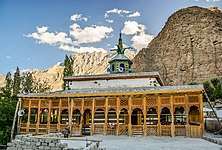Chaqchan Mosque
The Chaqchan Mosque (Urdu: مسجد چقچن; meaning “The Miraculous Mosque”[1]) is a mosque in the city of Khaplu, in the Gilgit-Baltistan region of northern Pakistan. Dating from 1370, the mosque is one of the oldest in the region, and dates from the time when the area's populace converted en masse from Buddhism to Islam.[2][3] The mosque shares similar architecture as those built in the Kashmir Valley.[4] It is a perfect blend of Tibetan, Mughal and Persian style of architecture.[5]
| Chaqchan Mosque مسجد چقچن | |
|---|---|
 Chaqchan Mosque Front View from the Courtyard | |
| Religion | |
| Affiliation | Noorbakshia Islam |
| Location | |
| Location | Khaplu, Gilgit-Baltistan |
 Location in Pakistan | |
| Geographic coordinates | 35.156062°N 76.330582°E |
| Architecture | |
| Type | Mosque |
| Style | Tibetan, Mughal and Persian |
| Date established | 1370 AD |
| Capacity | 500 (including adjoining verandah) |
History
According to some sources the mosque was built by Mir Sayyid Ali Hamadani[6] while other say on arrival of Sufi saint Syed Nurbakhsh from Kashmir to Baltistan, the local ruling Raja accepted Islam and commissioned the building of the mosque[7] in 1370 CE. However, the dating of the latter theory contradicts historical source which suggests that the mosque was actually constructed more than two decade before the birth of Syed Nurbakhsh.
Conservation
The Government of Pakistan has listed the Chaqchan Mosque as a Pakistan Heritage Site. The mosque is now currently in use after extensive conservation works.
Architecture
Architecturally, the mosque is a perfect blend of Tibetan, Mughal and Persian styles,[8][9] and consists of a two-story cubic complex: Semi-basement, ground floor with a turret atop. The perimetral walls of the cubic structure are composed of wooden slabs stacked to form a frame with its void spaces daubed with clay or mud that is in fact this technology is similar to the Roman opus craticum technique. This method of construction is one of the oldest known for making a weatherproof structures and it is also suitable for harsh winter conditions.[10][11]
Gallery
 The mosque's interior with extensive woodwork
The mosque's interior with extensive woodwork View over the valley from the mosque
View over the valley from the mosque Chaqchan Mosque's Arches
Chaqchan Mosque's Arches
 The mosque's exterior
The mosque's exterior Chaqchan Mosque around 1st decade of 19 century
Chaqchan Mosque around 1st decade of 19 century The mosque's decorated mihrab
The mosque's decorated mihrab Portion of the decorated ceiling
Portion of the decorated ceiling Almost all surfaces of the mosque's interior, including its ceiling, are decorated
Almost all surfaces of the mosque's interior, including its ceiling, are decorated Interior decorations make use of vibrant colours
Interior decorations make use of vibrant colours
References
- Shahzad Bashir (2003). Messianic Hopes and Mystical Visions: The Nåurbakhshåiya Between Medieval. ISBN 9781570034954.
- "Chaqchan Mosque (Ghanche)".
- History of baltistan ,Hassan nurbakshi
- Asimov, Muchammed Sajfiddinoviĉ (1992). History of Civilizations of Central Asia (vol.4,part-2). Motilal Banarsidass. ISBN 9788120815964.
- Jajja, Sumiera (2001). Khaplu — off the beaten path. Dawn News.
- History and Culture of Baltistan,Hassan Hasrat
- Afridi, Banat Gul (1988). baltistan in history.
- Khan, Omar Mukhtar (10 May 2018). "With a historic fort and Unesco-protected mosque, Shigar is an ideal short escape in Gilgit-Baltistan". DAWN.COM.
- Jajja, Sumaira (27 July 2014). "Khaplu — off the beaten path". DAWN.COM.
- Two Oldest Mosques of Sub-continent
- Ghanche is one of the most beautiful and culturally rich valleys of Gilgit-Baltistan